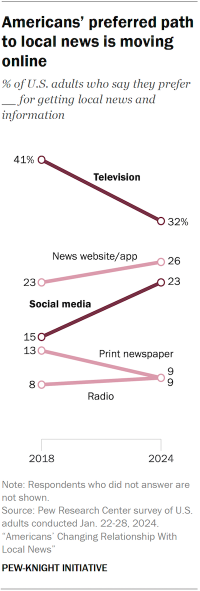
The way Americans get local news is changing, both in terms of which devices they’re using and who is delivering the news.
Television is still the most common way people prefer to get their local news, but it is no longer dominant as digital pathways to news continue to rise.
About a third of U.S. adults (32%) say they prefer to get their local news via television, a decline from 41% in 2018. Meanwhile, the share who prefer to get local news from social media has increased, from 15% in 2018 to 23% today. And roughly a quarter of adults (26%) say they prefer to use news websites. Combined, about half of U.S. adults prefer to get news through one of these digital platforms – even if the content they’re getting may be coming from traditional media outlets with an online presence.
Fewer Americans prefer print newspapers and radio for local news (9% each). The share who say they prefer print newspapers has dropped by 4 percentage points in the last six years.
Americans’ changing local news providers
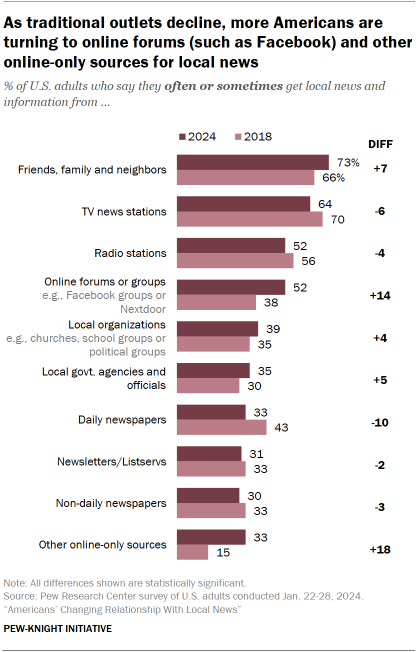
In addition to the technologies being used to access local news, the organizations and specific sources where people are getting local news also are evolving.
The share of Americans who say they often or sometimes get local news and information from daily newspapers has dropped from 43% in 2018 to 33% today – putting newspapers on par with government agencies as a source of local news. About twice as many people say they at least sometimes get news from local TV stations (64%), but this also represents a drop from 70% six years ago.
The two types of sources that have seen the most substantial growth are primarily digital by nature.
The share of U.S. adults who at least sometimes get news from online forums like Facebook groups increased from 38% in 2018 to 52% in 2024. More people also are getting news from online-only sources that aren’t included in any of the other categories (up from 15% in 2018 to 33% this year).
If respondents said they got news from one of these sources, we asked them to name (in their own words) a specific source they were thinking of as “online-only.” Respondents cited a variety of different types of sources, reflecting the complexity of the ever-changing online information environment.
Some people mentioned local websites and blogs, local news aggregator apps (such as NewsBreak), and specific Facebook groups and Instagram accounts. Others had more general responses such as social media sites more broadly (simply “Facebook”), search engines and online portals (such as Google or MSN), and outlets that cover more national news (e.g., CNN or Breitbart).
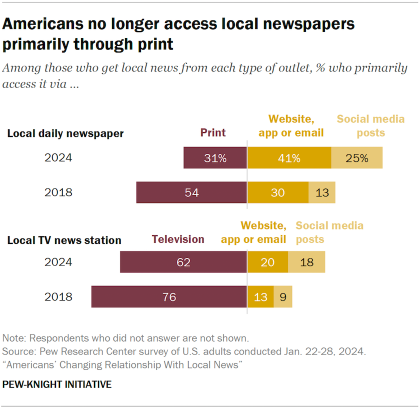
Growth in digital access extends to traditional news sources
The impact of digital technology is visible through how people access two more traditional sources of local news: daily newspapers and TV stations.
Many of these outlets now offer news not only in their original format (print and broadcast TV), but through websites and social media feeds as well. For example, among Americans who say they get news from local TV stations, a majority (62%) still say they primarily access it on a television, but 37% say they mainly access that information online – whether from a TV station’s website, app, email newsletter or social media posts.
Among those who get news from local daily newspapers, just 31% access it primarily via their print version. About two-thirds of those who get news from local daily papers (66%) primarily access them online, including 41% who say they use websites or apps and 25% who say they use social media.
How Americans access each of these types of outlets is becoming more digital. In 2018, people were more likely to access both local TV and newspapers via their original analog form: 76% of local TV consumers said they primarily accessed that news on TV, and 54% of daily newspaper users said they mostly used the print format.
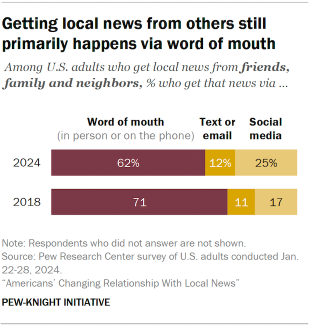
Even the way that people get information from friends and family shows signs of change.
A majority of Americans say they often (18%) or sometimes (55%) get local news from other people in their community, such as friends, family or neighbors. In 2018, a slightly smaller share said they got local news this way often (17%) or sometimes (49%).
News from friends, family and neighbors is still most often shared by word of mouth (i.e., in person or on the phone), but it is increasingly likely to be shared on social media. Among those who get local news from people in their community, 25% now say that primarily happens on social media, up from 17% in 2018.
Americans’ awareness of the outlets covering their local area
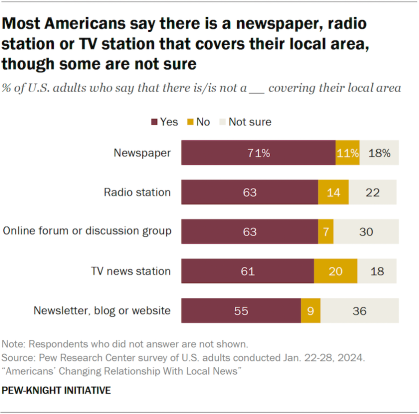
How Americans access their local news first depends on whether they have local outlets available to them – and not everyone does. Others aren’t aware if there are specific types of sources that cover their local area.
We asked Americans whether or not there are newspapers, radio stations, online forums, TV news stations, or newsletters or blogs that cover their local area. For all five types of sources, more than half of Americans say there is at least one of these covering their area, although more say this about newspapers (71%) than other types of sources.
In each case, some respondents say their area doesn’t have a certain type of news outlet. For instance, 20% of respondents say their area doesn’t have a TV station, 14% say there is no radio station and 11% say their area doesn’t have a local newspaper.
In addition, substantial shares say they are not sure whether their area has each type of source, including 30% who aren’t sure if there is an online news forum in their area and 36% who aren’t sure if there is a local newsletter, blog or website.
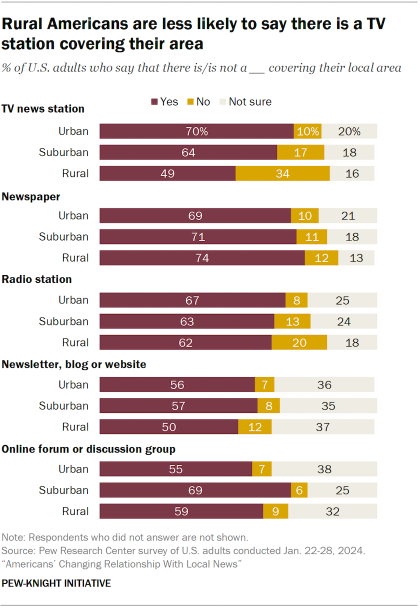
Some of this availability is connected to where respondents live – especially for local television stations. Americans who live in rural areas are much less likely to say there is a TV station covering their local area – 49% say there is, vs. 64% of those living in suburban areas and 70% of those in urban areas.
About a third of rural Americans (34%) say they do not have a TV station that covers their area, and 16% say they are not sure. By contrast, 17% of those in the suburbs and 10% of those in urban areas say there is no local TV station.
Americans in the suburbs, on the other hand, stand out for being more likely to say there are online forums or discussion groups (such as on Facebook or Nextdoor) in their local area. About seven-in-ten suburban Americans (69%) say there is at least one of these types of groups, compared with 55% of urban and 59% of rural Americans who say the same.




